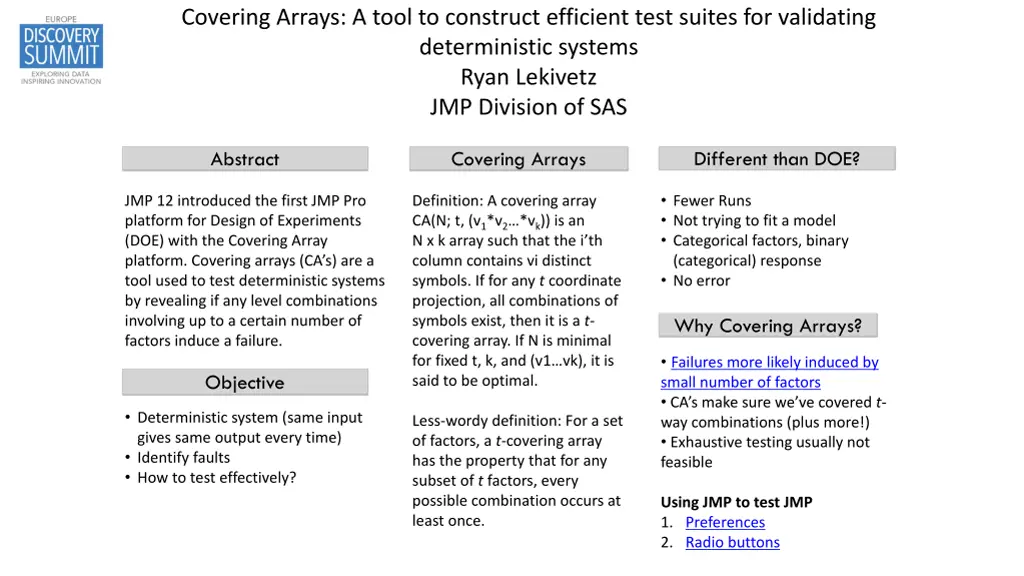
Efficient Test Suite Construction Using Covering Arrays
Discover how Covering Arrays provide an effective tool to validate deterministic systems by efficiently testing subsets of factors, identifying faults, and optimizing test coverage. Learn the benefits of Covering Arrays and their application in testing scenarios.
Download Presentation

Please find below an Image/Link to download the presentation.
The content on the website is provided AS IS for your information and personal use only. It may not be sold, licensed, or shared on other websites without obtaining consent from the author. If you encounter any issues during the download, it is possible that the publisher has removed the file from their server.
You are allowed to download the files provided on this website for personal or commercial use, subject to the condition that they are used lawfully. All files are the property of their respective owners.
The content on the website is provided AS IS for your information and personal use only. It may not be sold, licensed, or shared on other websites without obtaining consent from the author.
E N D
Presentation Transcript
Covering Arrays: A tool to construct efficient test suites for validating deterministic systems Ryan Lekivetz JMP Division of SAS Different than DOE? Abstract Covering Arrays Fewer Runs Not trying to fit a model Categorical factors, binary (categorical) response No error JMP 12 introduced the first JMP Pro platform for Design of Experiments (DOE) with the Covering Array platform. Covering arrays (CA s) are a tool used to test deterministic systems by revealing if any level combinations involving up to a certain number of factors induce a failure. Definition: A covering array CA(N; t, (v1*v2 *vk)) is an N x k array such that the i th column contains vi distinct symbols. If for any t coordinate projection, all combinations of symbols exist, then it is a t- covering array. If N is minimal for fixed t, k, and (v1 vk), it is said to be optimal. Why Covering Arrays? Failures more likely induced by small number of factors CA s make sure we ve covered t- way combinations (plus more!) Exhaustive testing usually not feasible Objective Deterministic system (same input gives same output every time) Identify faults How to test effectively? Less-wordy definition: For a set of factors, a t-covering array has the property that for any subset of t factors, every possible combination occurs at least once. Using JMP to test JMP 1. Preferences 2. Radio buttons
Covering Arrays Ryan Lekivetz JMP Division of SAS Factors Disallowed Combinations Enter Categorical factors Continuous factors need to be converted into a discrete number to input as categorical Choose strength Higher strength = ascertain better coverage at cost of more runs Specify combinations that cannot occur Disallowed Combinations Filter creates script that can be used later Unlike rest of DOE, it s fine if you end up with missing values in the design
Covering Arrays Ryan Lekivetz JMP Division of SAS After Make Design After Make Table 100% of 2-factor combinations 91% of 3-factor combinations Response column keeps track of pass/fail results If there s a failure, would like to know the cause Analysis tool provides a set of possible causes by considering the entire set of passes and fails Metrics reveal how well combinations covered in projections of t factors Optimize tries to find a smaller design Optimize disabled if design is known to be smallest
Covering Arrays Ryan Lekivetz JMP Division of SAS Testing Preferences Categorical platform preference set has lots of checkboxes (2-level), as well as a few options with 3 or more choices 712,483,534,798,848 possible combinations to test Covering array starts with a 20-run design for strength 2 In a few seconds, Optimize finds a 16-run design, which is the minimum run size
Covering Arrays Ryan Lekivetz JMP Division of SAS Testing Factors that cannot be run together Level setting of one particular factor implies that other factors are not applicable For example, may have a radio button, each choice having its own set of options that follow Automated Hierarchical Clustering => options for interactive/minimum don t apply Some workarounds: Create separate design for each choice (wasteful testing) Make combined factors (hard to read/decipher) Instead use disallowed combinations Sensible missing values in the design Analysis still works too
Covering Arrays Ryan Lekivetz JMP Division of SAS Effectiveness of Covering Arrays #factors involved in failure Medical devices Browser Server NASA GSFC 1 2 3 4 5 6 66 97 99 100 29 76 95 97 99 100 42 70 89 96 96 100 68 93 98 100 Cumulative percentage of faults triggered by interactions involving number of factors indicated in leftmost column (Kuhn et al. (2004)). D. Kuhn, D. R. Wallace, & A. M. Gallo, Software Fault Interactions & Implications for Software Testing, IEEE TSE, 30(6), 2004, 418-421

![[READ DOWNLOAD] Wish Upon a Cowboy (Cowboys of Creedence, 4)](/thumb/42218/read-download-wish-upon-a-cowboy-cowboys-of-creedence-4.jpg)




















